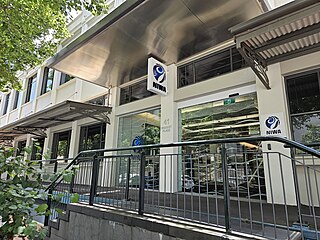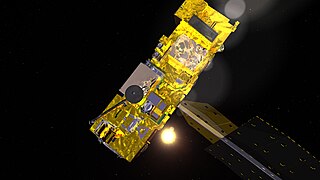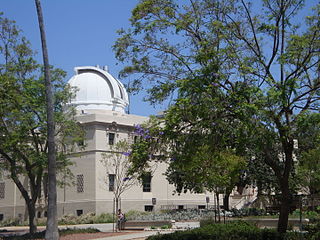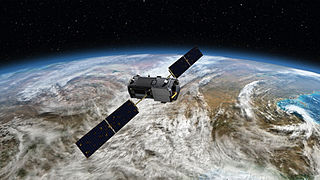Related Research Articles

Satellite temperature measurements are inferences of the temperature of the atmosphere at various altitudes as well as sea and land surface temperatures obtained from radiometric measurements by satellites. These measurements can be used to locate weather fronts, monitor the El Niño-Southern Oscillation, determine the strength of tropical cyclones, study urban heat islands and monitor the global climate. Wildfires, volcanos, and industrial hot spots can also be found via thermal imaging from weather satellites.

Ground-level ozone (O3), also known as surface-level ozone and tropospheric ozone, is a trace gas in the troposphere (the lowest level of the Earth's atmosphere), with an average concentration of 20–30 parts per billion by volume (ppbv), with close to 100 ppbv in polluted areas. Ozone is also an important constituent of the stratosphere, where the ozone layer (2 to 8 parts per million ozone) exists which is located between 10 and 50 kilometers above the Earth's surface. The troposphere extends from the ground up to a variable height of approximately 14 kilometers above sea level. Ozone is least concentrated in the ground layer (or planetary boundary layer) of the troposphere. Ground-level or tropospheric ozone is created by chemical reactions between NOx gases (oxides of nitrogen produced by combustion) and volatile organic compounds (VOCs). The combination of these chemicals in the presence of sunlight form ozone. Its concentration increases as height above sea level increases, with a maximum concentration at the tropopause. About 90% of total ozone in the atmosphere is in the stratosphere, and 10% is in the troposphere. Although tropospheric ozone is less concentrated than stratospheric ozone, it is of concern because of its health effects. Ozone in the troposphere is considered a greenhouse gas, and may contribute to global warming.

Mars 96 was a failed Mars mission launched in 1996 to investigate Mars by the Russian Space Forces and not directly related to the Soviet Mars probe program of the same name. After failure of the second fourth-stage burn, the probe assembly re-entered the Earth's atmosphere, breaking up over a 320 km (200 mi) long portion of the Pacific Ocean, Chile, and Bolivia. The Mars 96 spacecraft was based on the Phobos probes launched to Mars in 1988. They were of a new design at the time and both ultimately failed. For the Mars 96 mission the designers believed they had corrected the flaws of the Phobos probes, but the value of their improvements was never demonstrated due to the destruction of the probe during the launch phase.
SCISAT-1 is a Canadian satellite designed to make observations of the Earth's atmosphere. Its main instruments are an optical Fourier transform infrared spectrometer, the ACE-FTS Instrument, and an ultraviolet spectrophotometer, MAESTRO. These devices record spectra of the Sun, as sunlight passes through the Earth's atmosphere, making analyses of the chemical elements of the atmosphere possible.

The Upper Atmosphere Research Satellite (UARS) was a NASA-operated orbital observatory whose mission was to study the Earth's atmosphere, particularly the protective ozone layer. The 5,900-kilogram (13,000 lb) satellite was deployed from Space Shuttle Discovery during the STS-48 mission on 15 September 1991. It entered Earth orbit at an operational altitude of 600 kilometers (370 mi), with an orbital inclination of 57 degrees.

The National Institute of Water and Atmospheric Research or NIWA, is a Crown Research Institute of New Zealand. Established in 1992, NIWA conducts research across a broad range of disciplines in the environmental sciences. It also maintains nationally and, in some cases, internationally important environmental monitoring networks, databases, and collections.

The atmosphere of Mars is the layer of gases surrounding Mars. It is primarily composed of carbon dioxide (95%), molecular nitrogen (2.85%), and argon (2%). It also contains trace levels of water vapor, oxygen, carbon monoxide, hydrogen, and noble gases. The atmosphere of Mars is much thinner and colder than Earth's having a max density 20g/m3 with a temperature generally below zero down to -60 Celsius. The average surface pressure is about 610 pascals (0.088 psi) which is less than 1% of the Earth's value.

Venera-D is a proposed Russian space mission to Venus that would include an orbiter and a lander to be launched in 2029. The orbiter's prime objective is to perform observations with the use of a radar. The lander, based on the Venera design, would be capable of operating for a long duration on the planet's surface. The "D" in Venera-D stands for "dolgozhivuschaya," which means "long lasting" in Russian.

Over the last two centuries many environmental chemical observations have been made from a variety of ground-based, airborne, and orbital platforms and deposited in databases. Many of these databases are publicly available. All of the instruments mentioned in this article give online public access to their data. These observations are critical in developing our understanding of the Earth's atmosphere and issues such as climate change, ozone depletion and air quality. Some of the external links provide repositories of many of these datasets in one place. For example, the Cambridge Atmospheric Chemical Database, is a large database in a uniform ASCII format. Each observation is augmented with the meteorological conditions such as the temperature, potential temperature, geopotential height, and equivalent PV latitude.

The atmospheric infrared sounder (AIRS) is one of six instruments flying on board NASA's Aqua satellite, launched on May 4, 2002. The instrument is designed to support climate research and improve weather forecasting.

The Solar Backscatter Ultraviolet Radiometer, or SBUV/2, is a series of operational remote sensors on NOAA weather satellites in Sun-synchronous orbits which have been providing global measurements of stratospheric total ozone, as well as ozone profiles, since March 1985. The SBUV/2 instruments were developed from the SBUV experiment flown on the Nimbus-7 spacecraft which improved on the design of the original BUV instrument on Nimbus-4. These are nadir viewing radiometric instruments operating at mid to near UV wavelengths. SBUV/2 data sets overlap with data from SBUV and TOMS instruments on the Nimbus-7 spacecraft. These extensive data sets measure the density and vertical distribution of ozone in the Earth's atmosphere from six to 30 miles.
The Stratospheric Aerosol and Gas Experiment (SAGE) is a series of remote sensing satellite instruments used to study the chemical composition of Earth's atmosphere. Specifically, SAGE has been used to study the Earth's ozone layer and aerosols at the troposphere through the stratosphere. The SAGE instruments use solar occultation measurement technique to determine chemical concentrations in the atmosphere. Solar occultation measurement technique measures sunlight through the atmosphere and ratios that measurement with a sunlight measurement without atmospheric attenuation. This is achieved by observing sunrises and sunsets during a satellite orbit. Physically, the SAGE instruments measure ultraviolet/visible energy and this is converted via algorithms to determine chemical concentrations. SAGE data has been used to study the atmospheres aerosols, ozone, water vapor, and other trace gases.

Greenhouse gas monitoring is the direct measurement of greenhouse gas emissions and levels. There are several different methods of measuring carbon dioxide concentrations in the atmosphere, including infrared analyzing and manometry. Methane and nitrous oxide are measured by other instruments. Greenhouse gases are measured from space such as by the Orbiting Carbon Observatory and networks of ground stations such as the Integrated Carbon Observation System.

SAGE III on ISS is the fourth generation of a series of NASA Earth-observing instruments, known as the Stratospheric Aerosol and Gas Experiment. The first SAGE III instrument was launched on a Russian Meteor-3M satellite. The recently revised SAGE III was mounted to the International Space Station where it uses the unique vantage point of ISS to make long-term measurements of ozone, aerosols, water vapor, and other gases in Earth's atmosphere.

The Total Carbon Column Observing Network (TCCON) is a global network of instruments that measure the amount of carbon dioxide, methane, carbon monoxide, nitrous oxide and other trace gases in the Earth's atmosphere. The TCCON began in 2004 with the installation of the first instrument in Park Falls, Wisconsin, USA, and has since grown to 23 operational instruments worldwide, with 7 former sites.
OSIRIS is an instrument that measures vertical profiles of spectrally dispersed, limb scattered sunlight from the upper troposphere into the lower mesosphere. OSIRIS is one of two instruments on the Odin satellite, launched February, 2001 into a Sun-synchronous, 6 pm/6 am local time orbit at 600 km. This restricts OSIRIS sunlit observations to the Northern hemisphere in May, June, July and August, and the Southern hemisphere in November, December, January and February. Global coverage from 82°S to 82°N occurs on the months adjoining the equinoxes. OSIRIS measurements began November, 2001 and continue to the present.

Meteor-3M No.1 was the first and only of the Meteor-3M series polar-orbiting weather satellites. It was launched on 10 December 2001 at 17:18:57 UTC from the Baikonur Cosmodrome in Kazakhstan. The satellite is in a Sun-synchronous orbit with an ascending node time of about 9AM.

Space-based measurements of carbon dioxide are used to help answer questions about Earth's carbon cycle. There are a variety of active and planned instruments for measuring carbon dioxide in Earth's atmosphere from space. The first satellite mission designed to measure CO2 was the Interferometric Monitor for Greenhouse Gases (IMG) on board the ADEOS I satellite in 1996. This mission lasted less than a year. Since then, additional space-based measurements have begun, including those from two high-precision satellites. Different instrument designs may reflect different primary missions.

SPRITE was a proposed Saturn atmospheric probe mission concept of the NASA. SPRITE is a design for an atmospheric entry probe that would travel to Saturn from Earth on its own cruise stage, then enter the atmosphere of Saturn, and descend taking measurements in situ.
Nadir and Occultation for MArs Discovery (NOMAD) is a 3-channel spectrometer on board the ExoMars Trace Gas Orbiter (TGO) launched to Mars orbit on 14 March 2016.
References
- ↑ "Paul O. Wennberg". Caltech. Archived from the original on 24 August 2018. Retrieved 10 May 2016.
- 1 2 3 4 "Paul O. Wennberg". Environmental Science and Engineering. Retrieved 10 May 2016.
- 1 2 Griffith, D. (2014). "Near Infrared remote sensing of atmospheric composition from the ground and space: the Total Carbon Column Observing Network (TCCON), GOSAT and OCO-2". Light, Energy and the Environment, OSA Technical Digest: ETh4A.2. doi:10.1364/E2.2014.ETh4A.2. ISBN 978-1-55752-756-1 . Retrieved 12 May 2016.
- 1 2 Crisp, D.; Atlas, R.M; Breon, F.-M; Brown, L.R; Burrows, J.P; Ciais, P.; Connor, B.J; Doney, S.C; Fung, I.Y; Jacob, D.J; Miller, C.E; O'Brien, D.; Pawson, S.; Randerson, J.T; Rayner, P.; Salawitch, R.J; Sander, S.P; Sen, B.; Stephens, G.L; Tans, P.P; Toon, G.C; Wennberg, P.O; Wofsy, S.C; Yung, Y.L; Kuang, Z.; Chudasama, B.; Sprague, G.; Weiss, B.; Pollock, R.; et al. (2004). "The Orbiting Carbon Observatory (OCO) mission". Advances in Space Research. 34 (4): 700–709. Bibcode:2004AdSpR..34..700C. doi:10.1016/j.asr.2003.08.062. S2CID 16804121.
- 1 2 3 Oliwenstein, Lori (2010). "Caltech, Canadian Space Agency Awarded NASA Project to Develop Spectrometer Headed to Mars". Caltech News. Retrieved 12 May 2016.
- 1 2 3 Morin, Monte (June 30, 2014). "NASA makes second attempt to launch CO2-measuring satellite". Los Angeles Times. Retrieved 10 May 2016.
- 1 2 3 The John D. and Catherine T. MacArthur Foundation. "MacArthur Fellows September 2002" . Retrieved 2007-06-02.
- ↑ Wennberg, Paul. "Paul Wennberg / Caltech". Caltech. Retrieved 10 May 2016.
- ↑ "Anderson Research Group". Harvard College. Retrieved 10 May 2016.
- 1 2 3 "Paul O. Wennberg (C.V.)" (PDF). Caltech. Retrieved 12 May 2016.
- ↑ "Linde + Robinson Laboratory at Caltech". Los Angeles Conservancy. Retrieved 10 May 2016.
- ↑ Wennberg, P. O.; Cohen, R. C.; Hazen, N. L.; Lapson, L. B.; Allen, N. T.; Hanisco, T. F.; Oliver, J. F.; Lanham, N. W.; Demusz, J. N.; Anderson, J. G. (1994). "Aircraft-borne, laser-induced fluorescence instrument for the in situ detection of hydroxyl and hydroperoxyl radicals" (PDF). Review of Scientific Instruments. 65 (6): 1858–1876. Bibcode:1994RScI...65.1858W. doi:10.1063/1.1144835.
- 1 2 3 4 North, Gerald R.; Pyle, John A.; Zhang, Fuqing (2014). Encyclopedia of atmospheric sciences. Elsevier Academic Press. pp. 393–394. ISBN 9780123822253 . Retrieved 11 May 2016.
- 1 2 "HOx Research Group". Anderson Group. Archived from the original on 29 June 2016. Retrieved 12 May 2016.
- ↑ Wennberg, P. O.; Cohen, R. C.; Stimpfle, R. M.; Koplow, J. P.; Anderson, J. G.; Salawitch, R. J.; Fahey, D. W.; Woodbridge, E. L.; Keim, E. R.; Gao, R. S.; Webster, C. R.; May, R. D.; Toohey, D. W.; Avallone, L. M.; Proffitt, M. H.; Loewenstein, M.; Podolske, J. R.; Chan, K. R.; Wofsy, S. C. (1994). "Removal of Stratospheric O3 by Radicals: In Situ Measurements of OH, HO2, NO, NO2, ClO, and BrO". Science. 266 (5184): 398–404. Bibcode:1994Sci...266..398W. doi:10.1126/science.266.5184.398. PMID 17816682. S2CID 2520718.
- ↑ Wennberg, P. O.; Hanisco, T. F.; Jaegle, L.; Jacob, D. J.; Hintsa, E. J.; Lanzendorf, E. J.; Anderson, J. G.; Gao, R.; Keim, E. R.; Donnelly, S. G.; Negro LAD; Fahey, D. W.; McKeen, S. A.; Salawitch, R. J.; Webster, C. R.; May, R. D.; Herman, R. L.; Proffitt, M. H.; Margitan, J. J.; Atlas, E. L.; Schauffler, S. M.; Flocke, F.; McElroy, C. T.; Bui, T. P. (1998). "Hydrogen Radicals, Nitrogen Radicals, and the Production of O3 in the Upper Troposphere". Science. 279 (5347): 49–53. Bibcode:1998Sci...279...49W. doi:10.1126/science.279.5347.49. PMID 9417019.
- ↑ St. Clair, J. M.; Hanisco, T. F.; Weinstock, E. M.; Moyer, E. J.; Sayres, D. S.; Keutsch, F. N.; Kroll, J. H.; Demusz, J. N.; Allen, N. T.; Smith, J. B.; Spackman, J. R.; Anderson, J. G. (2008). "A new photolysis laser-induced fluorescence instrument for the detection of H2O and HDO in the lower stratosphere" (PDF). Review of Scientific Instruments. 79 (6): 064101–064101–14. Bibcode:2008RScI...79f4101S. doi:10.1063/1.2940221. PMID 18601418.
- 1 2 Wunch, D.; Toon, G. C.; Blavier, J.-F. L.; Washenfelder, R. A.; Notholt, J.; Connor, B. J.; Griffith, D. W. T.; Sherlock, V.; Wennberg, P. O. (2011). "The Total Carbon Column Observing Network". Philosophical Transactions of the Royal Society A: Mathematical, Physical and Engineering Sciences. 369 (1943): 2087–2112. Bibcode:2011RSPTA.369.2087W. doi: 10.1098/rsta.2010.0240 . PMID 21502178.
- 1 2 3 Stoller-Conrad, Jessica (2014). "Integrating Carbon from the Ground Up: TCCON Turns Ten" (PDF). The Earth Observer. 26 (4): 13–15. Retrieved 12 May 2016.
- 1 2 "Carbon cycle and ecosystems funded research". National Aeronautics and Space Administration. Retrieved 12 May 2016.
- ↑ Fesenmaier, Kimm (April 18, 2016). "Aliso Canyon, Methane, and Global Climate: A Conversation with Paul Wennberg". Science and Technology Research News. Retrieved 12 May 2016.
- ↑ Frankenberg, C.; Pollock, R.; Lee, R. A. M.; Rosenberg, R.; Blavier, J.-F.; Crisp, D.; O'Dell, C. W.; Osterman, G. B.; Roehl, C.; Wennberg, P. O.; Wunch, D. (2015). "The Orbiting Carbon Observatory (OCO-2): Spectrometer performance evaluation using pre-launch direct sun measurements". Atmospheric Measurement Techniques. 8 (1): 301–313. Bibcode:2015AMT.....8..301F. doi: 10.5194/amt-8-301-2015 .
- ↑ "President names outstanding young U.S. scientists". The White House. February 10, 1999.
- ↑ Maugh II, Thomas H. (September 25, 2002). "Eight Californians Win MacArthur Fellowships". Los Angeles Times. Retrieved 12 May 2016.